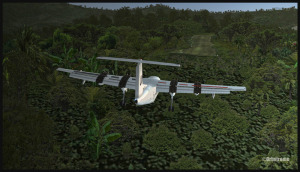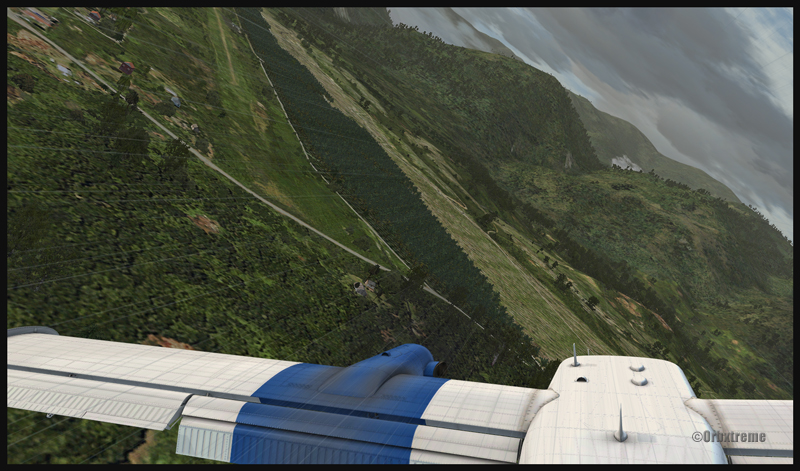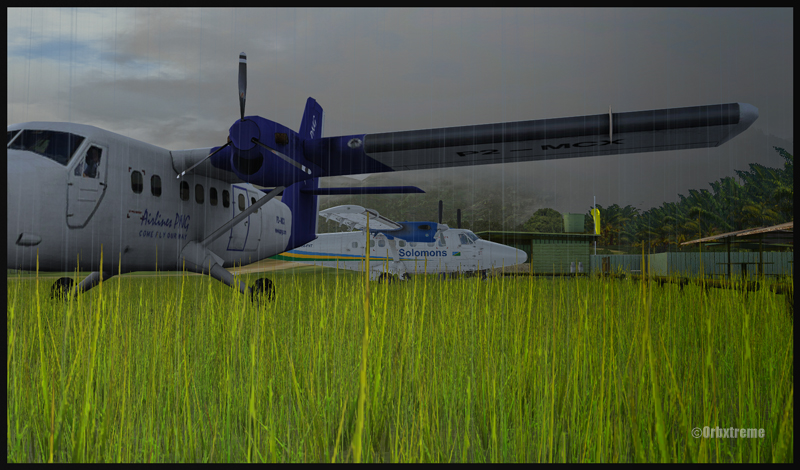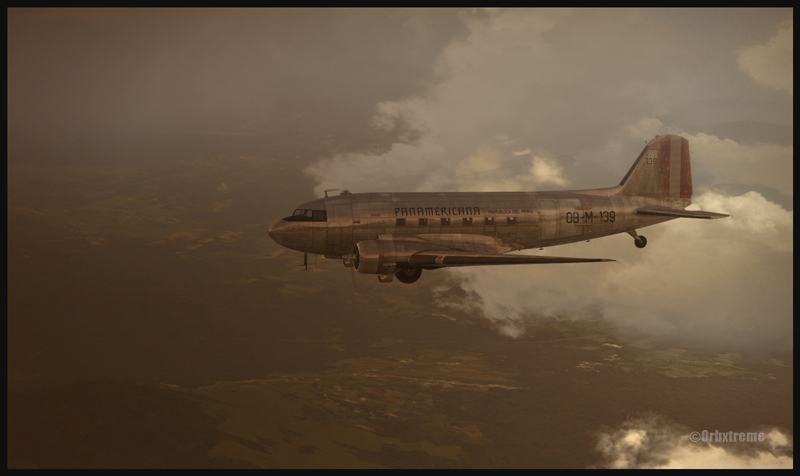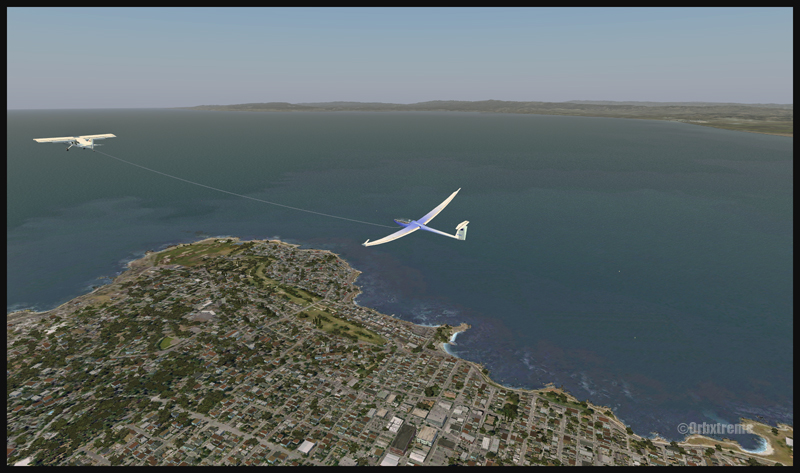The screen capture shows an Alabeo company Waco YMF5 in action. The background scene is a creation of ORBX. FSX has been used for this virtual flight over Alberta. The Waco is easy to fly and Alabao has programmed many point of views from which the virtual pilot can take pictures in flight. ( V on the keyboard). Airdrie Airpark, Claresholm Industrial Park and High River, all created by Vlad Maly, can be found near the training area. They are all quality products. The first airport must be bought but the two others are offered as freewares by Orbx. It is an interesting point of departure for a virtual pilot who would like to cross the Rockies towards Vancouver or Victoria.
Tag: FSX
If you are looking for a real challenge, try a flight from Kokoda airport to Kagi, using a DHC-7. Kagi is situated along the Kokoda Trail in Papua New Guinea. The runway has a 12.5 degree slope and is approximately 447m long (1466 ft). The airstrip’s altitude is about 3900 ft msl. You will need the ORBX scenery (AYPY) Jacksons Airport made by Ken Hall and Tim Harris, as well as other Orbx products such as Global, Vector and Holgermesh to do the flight and obtain the same views as above. In order to find the airports, two maps are included in the “User documents” included with AYPY.
I adjusted the fuel at 50% in each tank. For payload, I used 5 passengers and luggages. Obviously, the aircraft could have been loaded with many more passengers and cargo. But since it was a first trial at Kagi with a Dash 7, I thought that a lighter payload would increase my chances of a successful landing by reducing the approach speed.
The landing in Kagi is made on runway 07 and the takeoff on runway 25. From Kokoda airport, follow the Kokoda trail then, when appropriate, make a right turn toward Kagi. There are few airports within a small area so it can get a bit confusing. The best way is to overfly the area slowly to ensure that what you see in flight and what is on the map are both the same airport.
The two most difficult aspects of the approach are the steep turns required while flying close to the mountains in slow flight configuration, that is to say with full flaps and wheels out. The second problem to keep in mind is the sloped runway: 12.5 degrees is not negligeable. But once you are on the runway, the Dash 7 will almost stop by himself due to that slope. The takeoff on runway 25 is not a problem with that aircraft: with such a sloped runway, you will be airborne in no time.
I am convinced you will enjoy this demanding flight. There are lots of plants and trees included in the scenery, so it makes for a very realistic approach. Have fun and make sure your passengers will still have a smile on their face when they get out of the airplane!
P.S.: The flight was made using FSX
For more articles on flight simulation on my web site, click on the following links: Challenging virtual flights or Flight simulation
Finally,few months after the creation of the AYPY scenery, I can now do a first flight in Papua New Guinea. The complete flight, which consists of thirteen pictures, can be found in the “flight simulation” section above, under “standard virtual flights”. Why “standard”? When we know the degree of difficulty of some Papua New Guinea runways, which are short and hardly accessible, a flight like this one is considered relatively simple and allows the pilots to familiarize themselves in that part of the world. The scenery is called AYPY Port Moresby Jacksons International and it has been created by Ken Hall and Tim Harris, from the Orbx company. Details regarding the flight can also be found in the virtual flight section above. Two words only to describe the experience: totally immersive. Have a good flight!
Here is an edited screen capture that was added recently in the “flight simulation” section above, under “virtual pictures”. This virtual flight was made using Microsoft Flight Simulator (FSX). The scenery, very well executed by Orbx, represents the Palm Springs region, in United States. It is the most recent addition to the collection of virtual airports available for the California region. The F-14, made by Dino Cattaneo, is a freeware (check the free download links that is provided). This combination of plane and airport is certainly going to please the virtual flight enthousiast!
A virtual FedEx MD-11 from PMDG
The MD-11 is an extremely interesting aircraft with regards to its characteristics but many pilots have had problems to master all its interesting features in real life. It’s partly for that reason that there has been many crashes with this type of aircraft. Considering the MD-11 high fuel consumption, FedEx will progressively start selling them, starting 2015. The only company in the world still using the MD-11 to carry passengers is KLM (edit: it did the last flight with passengers in 2015). The MD-11 is remembered for the Swissair 111 crash, near the coast of Nova-Scotia, on Septembre 2nd, 1998. It was flying the New-York to Geneva leg when the accident happened: 229 persons perished when the aircraft plunged into the sea.
The above screen capture has been edited to give it a more realistic effect and to emphasize the quality of light at dusk. Different images, under many company colors, can be found on this website under the « flight simulation” category, within the ” virtual pictures » section. A flight from Mexico City Intl to Denver Intl will soon be included in the « challenging virtual flights » section. Have a good visit!
Hi,
Here is a little addition to the site for today, following a virtual flight made over Peru with the flight simulation software Microsoft Flight Simulator (FSX). Some modifications have been made to the screen capture in order to obtain the present result. The picture nonetheless reflects very well the atmosphere during that flight. For those who would like to know what software was used to produce the clouds, it was only FSX with ORBX 5 selection in the weather section. This selection always manages to offer an interesting sky.
François
Update October 19, 2014
Hi everybody!
Many pictures and articles have been added during the past few weeks. The last addition to this site can be found in the “flight simulation” section, under “standard virtual flights”. It’s a flight using FSX from Redding (California) toward Sekiu (Washington State). To make it easier for those of you who would like to try it, I’ve added the approach and stall speeds. The Phenom 100 is surprisingly easy to fly because it is a light jet with a low approach speed. It constitutes an excellent small jet for the pilot who wishes to transfer from piston engine aircraft toward jets. The virtual Phenom 100 is made by Carenado and the scenery by Orbx.
François
Here is a screen capture added recently to the flight simulation section, under “virtual pictures”. The Pitts Special was designed in Wyoming and the first one was built in 1971. This aircraft has won more open competitions in United States than any other type. Everyone who has flown the Pitts Special praise its quick reactions at the slightest pressure on the controls. In the actual scene, the aircraft is over the Monterey airport, a creation of Orbx for the FSX platform.
Intercepted!
The screen capture that you can see here has really not been planned. It is about the interception of a light twin engine aircraft by a Harrier military jet. After subscribing to an English virtual flying magazine, I received, as a welcome gift, this virtual military jet. As I was “in flight” familiarizing myself with the jet, I saw a little white dot moving in the distance. It was one of the numerous virtual aircrafts generated by the Microsoft Flight Simulator (FSX) program. The idea to simulate an interception and fly in formation with an unknown aircraft was just too good to resist. In few minutes, both aircrafts were in sight of each other. It was now a matter of adjusting the speed of the Harrier exactly with the other aircraft’s speed and progressively get closer. The picture represents the end result of this little meeting. The countryside under the planes is an ORBX creation.



